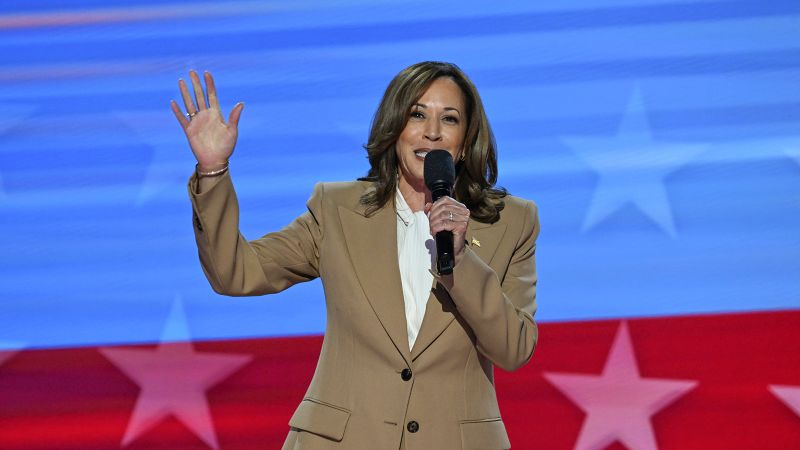CNN
—
The Harris coalition is coming into focus.
When Vice President Kamala Harris replaced President Joe Biden as the Democratic presidential nominee last month, her twin challenges were to shore up support with the groups where Biden was weak and to maintain his standing with the groups where he was relatively stronger.
As she arrives at the Democratic convention in Chicago this week, a broad array of polls testify to her progress on both tests. In both national and battleground state surveys, she’s regained a solid amount of the ground that Biden had lost with such traditionally Democratic-leaning groups as Black and younger voters, and made a more modest recovery with Latinos.
Simultaneously, in both national polls and surveys of the critical Rustbelt battlegrounds of Michigan, Pennsylvania and Wisconsin, she is matching or exceeding Biden’s showing among older and working-class Whites — two groups in which Biden had largely maintained his 2020 level of support before quitting the race.
Harris’ performance on each of these fronts has allowed her to pass former President Donald Trump in most polling averages measuring each candidates’ overall national support. More importantly, it has reopened the electoral map, providing her more pathways to 270 Electoral College votes than Biden had before he left the race. Her gains among younger and non-White voters have allowed her to put back into play Sunbelt battlegrounds that Biden’s struggles among those voters had moved largely beyond his reach. And in the Rustbelt battlegrounds that represented Biden’s most plausible path to 270 Electoral College votes, Harris looks stronger than the president did because she’s gaining there too among younger and non-White voters while running at least as well as he did among Whites.
But in the Rustbelt and Sunbelt alike, formidable challenges remain to this emerging “Kamala coalition.” Although Harris has demonstrably regained ground with younger, Black and Latino voters, in most polls she still lags below the levels Biden reached with them in 2020. It’s far from certain Harris can win any of the major Sunbelt battlegrounds — North Carolina and Georgia in the Southeast, Arizona and Nevada in the Southwest — unless she can come even closer to those previous Democratic benchmarks. And the remaining voters she needs may be tougher to corral than those that have already returned to her.
In the industrial states, she faces the challenge of defending the beachheads she’s established with working-class and older Whites, who comprise a much larger share of the vote in these places than in the Sunbelt battlegrounds. These White voters without a college degree will likely be the most receptive audience to the GOP arguments that Harris is soft on crime and immigration, and an extreme “woke” cultural liberal.
Mark Graul, a veteran GOP operative in Wisconsin, predicted that Harris’ support with these voters will erode as Republicans bombard them with advertising. “I think the surveys we are seeing right now are at or near her peak” with blue-collar White voters, he said. “If the Trump campaign does its job … that kind of messaging is going to drive those working-class White voters who may have been open to the excitement of ‘Hey, we got rid of Biden and I don’t like either of those guys’ to jump back [to Donald Trump].”
Yet it is significant that more working-class voters did not immediately move back to Trump in polls when Democrats replaced their 81-year-old White male nominee with a younger woman who would be the first Black woman and Indian American president. That suggests Harris’ race and gender do not render her intrinsically unacceptable to a larger group of these working-class Whites than the share that find it difficult to support any Democrat. That doesn’t mean Republicans ultimately can’t peel away more of those voters from her; but it does mean they will have to dislodge them, voter by voter, with their arguments and ads, rather than benefiting from an instinctive recoil to a woman of color nominee.
For now, polls generally show Harris generating at least as much support among working-class White voters as Biden did, both in his 2020 race and the polling before he left the 2024 race.
Biden didn’t run great with working-class White voters in 2020, but he did improve a few points over Hillary Clinton’s performance in 2016, reaching about one-third of their vote, according to the exit polls and the Pew Research Center’s well-respected validated voters study. Most significantly, the exit polls found that Biden gained over Clinton among them in Michigan and Wisconsin (where he carried about two-fifths of them) and Pennsylvania (where he won about one-third). That improvement, combined with a parallel uptick in support from college-educated White voters, allowed him to recapture all three states, after Trump in 2016 had dislodged them from what I called the “blue wall” — the 18 states that voted Democratic in each presidential election from 1992 through 2012.
Amid all his other problems this year, polls had shown Biden largely holding as much support among these blue-collar White voters as he did in his first contest with Trump. Harris today looks even a bit stronger. National surveys released in August by Marquette Law School, NPR/PBS NewsHour/Marist and Fox News Channel each showed her drawing 36-40% of non-college White voters, a share higher than Biden’s in 2020 and back in the range of Barack Obama’s performance in 2008 and 2012. ( The Washington Post/ABC/Ipsos poll released Sunday did not find Harris quite as strong, but still reported her slightly surpassing Biden’s performance among Whites without degrees.) New York Times/Siena College surveys found her matching or beating Biden’s 2020 showing in the exit polls with non-college educated Whites in each of Michigan, Pennsylvania and Wisconsin; another round of surveys from those pollsters released last weekend found her beating Biden’s share with those blue-collar Whites in North Carolina and Georgia, and exactly equaling them in Arizona and Nevada.
White men without a college degree could be an especially difficult audience for Harris, but many Democrats are hopeful she can remain competitive in these communities overall by maintaining relatively strong support among blue-collar White women. Both Biden and Hillary Clinton won only about 35% of them in the exit polls. But Democrats see an opportunity to improve on that since many of those women support legal abortion. With the concerns about Biden’s age and capability eliminated as a factor, Democrats also hope that more of those women may feel free to express their unease about Trump’s character and behavior: in a recent national New York Times/Siena poll, almost exactly half of White women without a college degree said they did not believe Trump had the temperament to succeed as president, according to detailed results provided by Siena.
Paul Maslin, a Democratic pollster with long experience in Wisconsin, argues that defending Harris against the GOP’s culturally based attacks on issues like crime and immigration aimed at these working-class White women is imperative for her campaign. Harris’ vulnerability to Republican attacks overall is less “than Biden had,” Maslin said. “But we are dreaming if we don’t think there is still some vulnerability. They have much better ground that they are going to get to here.”
Support for legal abortion and distaste for Trump’s behavior and leadership style could also allow Harris to expand on Biden’s already substantial margins among White women with at least a four-year college degree. It’s easy to forget that the six Republican-appointed Supreme Court justices overturned the constitutional right to abortion only after the 2020 election, when Biden already carried between 54-59% of college-educated White women, according to the major data sources. With abortion more politically relevant now than then, Harris has a good chance to exceed those numbers in 2024, many strategists in both parties believe.
Conversely, she will be challenged to preserve Biden’s 2020 support among college-educated White men, who are a receptive group for Trump’s arguments that, as a business executive, he can better manage the economy. But if she can avoid, or at least minimize, erosion with those men (who split almost evenly in 2020), she will be strongly positioned to improve over Biden’s 2020 showing with all college-educated Whites. Already the Marquette, Marist and Fox national polls, and the New York Times/Siena survey across the three big Rustbelt battlegrounds all showed her on track to exceed Biden’s 2020 showing with these voters. Running that well among college-educated White voters in places such as the suburbs of Philadelphia and Milwaukee, Oakland County outside Detroit, and Madison, Wisconsin, could allow her to survive some erosion compared to Biden in 2020 among Whites without a degree and still hold those three states.
While matching Biden’s relative strength among White voters is central to Harris’ prospects in the Rustbelt, reversing his weaknesses with younger and diverse voters is the key to her chances in the Sunbelt. Harris has also made progress on that task. But on this part of her test, her grade is more clearly an incomplete.
Over the past few weeks, surveys by Democratic operatives, or groups allied with the party, have all found Harris improving notably over Biden’s showing before he left the race with such core party constituencies as Latinos, young people, Black men and single women. But in each case, the surveys still showed her lagging Biden’s level of support with those groups in 2020. The recent New York Times/Siena surveys likewise showed Harris moving back past 80% among Black voters in both the industrial Midwest and Southeast but still lagging the roughly 90% or more Biden won last time in all those states. These polls also found Harris matching Biden’s 2020 share among Latinos in Arizona, but still substantially underperforming in Nevada.
Page Gardner, a veteran strategist for progressive groups, who sponsored the work on single women, explained their continued dip in support from 2020 by citing factors that are relevant to all the Democratic-leaning groups that had drifted away from Biden. The problem, Gardner said, starts with “economic factors – prices, with housing a particularly acute concern.” But the shortfall extends to a broader sense that the Biden years have not produced as much progress as these voters expected. “Although excitement and motivation has increased, there is an underlying sense of discouragement regarding things actually changing for them,” Gardner said. “Like so many others in the electorate, majorities of these women feel like they are losing power.”
Polling by Equis Research, a Democratic firm that recently conducted an in-depth survey of Latinos across the battleground states, found Harris gaining among both Latino women and men, but still running much better among the former than the latter. Carlos Odio, the Equis co-founder and senior vice president for research, said he believes Harris eventually could equal or surpass Biden’s 2020 Latino performance, but acknowledges she remains below that level now in the group’s polling.
“She clearly has gotten a good will boost; people like her; people like that she represents a change; they generally have good feelings about her,” he said. “But especially for the voters who are still up for grabs, they are waiting to see what more she has to say on the economy.”
While “her entrance answers a lot of voters’ demands for something other than [the choices] they had before,” Odio added, “there’s always a concern with an unknown quantity: What do they represent, does she have any wacky views? I think a lot of what you are going to see from this campaign is reassurance.”
On Monday, the Black Men Vote PAC released a survey that likewise found Harris gaining across Michigan, Pennsylvania and Wisconsin with the men they focus on but Trump still roughly matching his improved performance with them in 2020, and showing the potential for even greater gains with younger men. “These findings indicate that there is still work to be done to secure the full support of this critical voter bloc,” the group said in a release announcing the results.
With young people, the story is similar. While surveys had often found Biden consistently underperforming vs. Trump among younger voters, the latest national and state polls generally show Harris restoring a solid advantage with them. But, as with the other groups, most surveys did not yet show her matching Biden’s roughly 3-in-5 support last time among adults younger than 30.
On a recent episode of The Daily Blast podcast with Greg Sargent, John Della Volpe, a Harvard Kennedy School expert on youth voting who is advising a super PAC trying to build support among young people for Democrats, said a recent poll he conducted found Harris drawing just over half of younger voters against Trump, after the former president stunningly led Biden with them in the group’s previous survey. “I don’t think that she would be comfortable with [that] margin a month or two months from now, honestly,” Della Volpe said. “This needs to get somewhere into the mid-50s, which … is what I think is required to feel comfortable about an Electoral College victory in November.”
The recent swing state polls released by a bipartisan team of pollsters for the Cook Political Report with Amy Walter underscored how these shifts have moved Harris back into contention, but hardly into a safe position, across the battlegrounds. The surveys found Harris numerically ahead of Trump in Michigan, Pennsylvania, Wisconsin, Arizona and North Carolina, tied in Georgia and numerically behind only in Nevada. In May, Cook’s polling found Trump ahead or tied with Biden in all seven states.
Patrick Toomey, a Democratic pollster who conducted the survey with a GOP partner, said gains with a broad range of groups had propelled Harris past Trump. “Harris is in a stronger position than Biden was in May because her candidacy has won over a mix of non-college White voters in Rust Belt States … and college-educated Whites in the Sun Belt while posting gains among Black women and Latina voters across” all the states, he said.
Still, like the polling by Democratic groups, the Cook battleground state surveys showed Harris underperforming with Black, Latino and young voters. Harris ran no better among Latino and Black men across the battleground states than Biden did in May, Toomey said. These trends leave the battleground states within reach for Trump, if he can discipline himself to mount a cohesive campaign against Harris as too liberal and inexperienced, argued Greg Strimple, the Republican pollster on the Cook survey. “There is a path for Trump,” Strimple said. “It’s just whether he can take it.”
Harris’ gains have virtually eradicated one previously critical category in the race: the heralded “double haters” who disliked both Trump and Biden. Multiple surveys, such as recent national polls by the Pew Research Center, ABC/Washington Post and Monmouth College, as well as Equis’ survey of Latino voters, have found that there are far fewer “double hater” voters negative on both Harris and Trump than there were voters negative on both Biden and Trump. That decline reflects Harris’ success at winning back many from the large pool of Democratic-leaning voters who could not support another Biden term.
“These were Democratic voters that we’ve lost,” said Stanley Greenberg, the long-time Democratic pollsters. “They are people that were voting strongly Democratic and had been alienated by inflation, and Biden just couldn’t get a hearing with them. Most of her gains have come from people who have been leaning into voting Democratic and want to see her succeed.”
Harris’ success at recapturing these Democratic-leaning younger, single and non-White voters alienated from Biden while holding his beachhead among older and working-class Whites has created a coalition strong enough to contest all the major battlegrounds, after many of them seemed already lost to Trump. But the continued limits on her support on both sides of this ledger means she isn’t guaranteed victory in any of the pivotal states.
“The trajectory before Biden’s withdrawal is that it looked very likely Donald Trump was going to be elected to a second term,” said Bryan Bennett, the senior director of polling and analytics at the Hub Project, a progressive organization. “Harris entering the equation has returned the race to a jump ball.”
That’s an inherently precarious position. But compared to their situation just one month ago, the Democrats gathering in Chicago this week will take those odds in a heartbeat.










